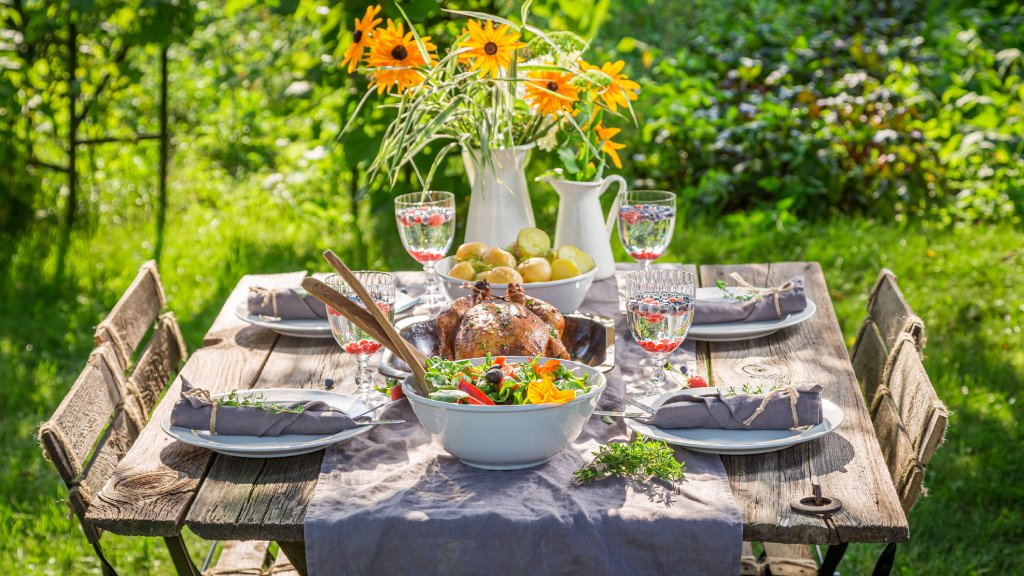How To Grow Garden To Table: A Guide For Home Cooks
What could be better than a meal that comes directly from garden to table? Show off your gardening and culinary skills with the very freshest food.


The term “garden to table” has gotten a lot of notice lately. Eating from garden to table minimizes your carbon footprint, allows you to control what goes into your food, and saves money. The farm to table garden is a fun way to introduce gardening to young people and can increase the variety of fruits and vegetables in your diet. A few tips on preparing a site and selecting plants will soon see you eating your own produce nearly year-round.
What Is Garden to Table?
Garden to table is the practice of growing your food near the home where it is harvested fresh and brought in to enjoy in recipes. Small eateries made the concept popular by either growing their own produce or sourcing from small farms. Foods from the garden to the table were touted as healthier, but they also yielded unusual produce not normally or easily found. They also ensured that the small farmer would have a steady income while reducing carbon with short-distance shipping.
Benefits of Growing Garden to Table
There are few drawbacks and many benefits to growing one's own food.
- The physical act of gardening and harvesting are excellent low-impact exercise routines.
- The practice allows the gardener to introduce unfound variety to the diet.
- The gardener controls what comes into the garden in the forms of insecticides, herbicides, types of fertilizer, contaminants, and other toxins.
- Gardening for mental wellness has been shown to elevate the mood.
- Gardening gives children an understanding of how and where food comes from.
- Sharing extra produce builds neighborly relations.
- It lowers waste as the gardener only grows what they prefer to eat.
- Garden to table practices can be translated into large or small spaces.
Planning Your Garden to Table Plot
Any good endeavor starts with planning, and such is the case when starting your own food garden. From location to variety of plants, there are several considerations. From a large garden plot to a patio garden, the size of the space will dictate many of the plant choices. So too will the growing conditions available in the selected area.
Where To Grow
A beginner’s farm to table guide must start with site and soil health. Take a look at the soil. Does it percolate well? Is it loose enough for plants like root vegetables? Is there enough organic matter available? Select a space with plenty of sunshine since most foods require light to produce fruits and vegetables. Make sure there is adequate water nearby, another crucial need for plants.
What To Grow
The least expensive way to start a garden to table space is by using seed. Most seeds can be started indoors in flats and planted outside when temperatures warm. Some plants are cool-season plants, such as spring onions, broccoli, kale, many lettuces, and snow peas. These can be started directly outside in garden beds, as can most root vegetables. Plan for well-rounded food options by installing berry canes and bushes, dwarf fruit trees, and other edible plants. Adding herbs and edible flowers will attract pollinators and enhance the flavor and color of dishes.
Harvesting And Storing Produce
Fresh produce is best but many foods store equally well either in cool storage or preserved in some manner. Even if the food is preserved it should be picked at optimum ripeness.
Sign up for the Gardening Know How newsletter today and receive a free copy of our e-book "How to Grow Delicious Tomatoes".
Use clean gloves or hands when harvesting food. Some gardeners believe foods will last longer if they are not washed until ready to eat. Still others believe pathogens may be brought in with the soil. If you wish to wash the produce, dry it well after cleaning it thoroughly. If not, shake or brush off excess dirt. Store produce in food-safe containers.
Only store foods that have no damage such as cuts or rotten spots. Most foods can be stored in the vegetable crisper for a few days. Some, like apples, onions, and potatoes, may be stored in a cool, dry location for months. Always check stored produce for any evidence of slime, softness, or other signs of spoilage.
Cooking From Garden To Table
Once the garden is up and running, the fun part starts. Cooking!
Many of our grown foods can be eaten raw and they exhibit a fresh crispness. Others require cooking, like potatoes. Still others are versatile. Carrots are equally good fresh, roasted, steamed, or sauteed. Starting to use your produce might begin with selecting a favorite recipe. Substitute your garden goodies for things you might have purchased in the past.
Experimenting with cooking techniques can elevate the flavor of foods. Grilled asparagus is a delight, while roasting root vegetables adds umami and sweet richness. And if you aren’t culinarily inclined, sometimes the best way to enjoy your hard work is via a salad filled with all the texture, flavor, and color of the varieties of produce you’ve grown.
This article features products available from third party vendors on the Gardening Know How Shop.

Bonnie Grant is a professional landscaper with a Certification in Urban Gardening. She has been gardening and writing for 15 years. A former professional chef, she has a passion for edible landscaping.
